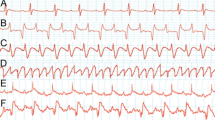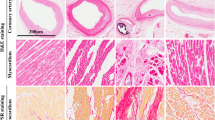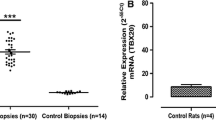Abstract
Sudden cardiac death (SCD) is the most frequent cause of sudden unexplained death in forensic practice. The most common cause of SCD is coronary artery disease related to coronary atherosclerosis. Previous study suggested the possible application of connexin 43 (Cx43) and zonula occludens-1 (ZO1) immunostaining in the early diagnosis of myocardial ischemia. However, there appears to be insufficient data with regard to their mRNA levels. The present study investigated the cardiac mRNA levels of Cx43 and ZO1, using forensic autopsy materials consisting of 41 control cases without any disease or structural abnormality of the heart (group 1), 32 deaths due to acute ischemic heart disease related to coronary atherosclerosis without apparent myocardial necrosis (group 2), and 29 traumatic deaths with coronary atherosclerosis (group 3). Ten candidate reference genes were evaluated in the left ventricles of 10 forensic autopsy cases. EEF1A1, PPIA, TPT1, and RPL13A were identified as the most stable reference genes. Using these validated reference genes, mRNA levels of Cx43 and ZO1 were examined in the bilateral ventricles and atria of the heart. Relative mRNA quantification demonstrated decreased calibrated normalized relative quantity (CNRQ) values of Cx43 and ZO1 in bilateral ventricles of group 2. When using one conventional reference gene (GAPDH or ACTB) for normalization, nearly no difference was detected among the three groups. These findings indicate that ventricular gap junction remodeling may be a key contributor to rhythm disturbances. Analysis of cardiac Cx43 and ZO1 using real-time PCR is useful in diagnosis of SCD, and validation of reference genes is crucial.




Similar content being viewed by others
References
Campuzano O, Allegue C, Partemi S, Iglesias A, Oliva A, Brugada R (2014) Negative autopsy and sudden cardiac death. Int J Legal Med 128(4):599–606
Chappex N, Schlaepfer J, Fellmann F, Bhuiyan ZA, Wilhelm M, Michaud K (2015) Sudden cardiac death among general population and sport related population in forensic experience. J Forensic Legal Med 35:62–68
Zhu BL, Ishikawa T, Michiue T, Li DR, Zhao D, Kamikodai Y, Tsuda K, Okazaki S, Maeda H (2006) Postmortem cardiac troponin T levels in the blood and pericardial fluid. Part 2: analysis for application in the diagnosis of sudden cardiac death with regard to pathology. Legal Med 8(2):94–101
Zhu BL, Ishikawa T, Michiue T, Li DR, Zhao D, Bessho Y, Kamikodai Y, Tsuda K, Okazaki S, Maeda H (2007) Postmortem cardiac troponin I and creatine kinase MB levels in the blood and pericardial fluid as markers of myocardial damage in medicolegal autopsy. Legal Med 9(5):241–250
Kawamoto O, Michiue T, Ishikawa T, Maeda H (2014) Immunohistochemistry of connexin43 and zonula occludens-1 in the myocardium as markers of early ischemia in autopsy material. Histol Histopathol 29(6):767–775
Mayer F, Propper S, Ritz-Timme S (2014) Dityrosine, a protein product of oxidative stress, as a possible marker of acute myocardial infarctions. Int J Legal Med 128(5):787–794
Ortmann C, Pfeiffer H, Brinkmann B (2000) A comparative study on the immunohistochemical detection of early myocardial damage. Int J Legal Med 113(4):215–220
Chen JH, Michiue T, Ishikawa T, Maeda H (2012) Pathophysiology of sudden cardiac death as demonstrated by molecular pathology of natriuretic peptides in the myocardium. Forensic Sci Int 223(1–3):342–348
Bayes de Luna A, Coumel P, Leclercq JF (1989) Ambulatory sudden cardiac death: mechanisms of production of fatal arrhythmia on the basis of data from 157 cases. Am Heart J 117(1):151–159
Cittadini F, De Giovanni N, Alcalde M, Partemi S, Carbone A, Campuzano O, Brugada R, Oliva A (2015) Genetic and toxicologic investigation of sudden cardiac death in a patient with arrhythmogenic right ventricular cardiomyopathy (ARVC) under cocaine and alcohol effects. Int J Legal Med 129(1):89–96
Kar R, Batra N, Riquelme MA, Jiang JX (2012) Biological role of connexin intercellular channels and hemichannels. Arch Biochem Biophys 524(1):2–15
Michela P, Velia V, Aldo P, Ada P (2015) Role of connexin 43 in cardiovascular diseases. Eur J Pharmacol 768:71–76
Gilleron J, Carette D, Fiorini C, Benkdane M, Segretain D, Pointis G (2009) Connexin 43 gap junction plaque endocytosis implies molecular remodelling of ZO-1 and c-Src partners. Commun Integr Biol 2(2):104–106
Chen JH, Michiue T, Ishikawa T, Maeda H (2012) Molecular pathology of natriuretic peptides in the myocardium with special regard to fatal intoxication, hypothermia, and hyperthermia. Int J Legal Med 126(5):747–756
Wang Q, Ishikawa T, Michiue T, Zhu BL, Guan DW, Maeda H (2013) Molecular pathology of brain edema after severe burns in forensic autopsy cases with special regard to the importance of reference gene selection. Int J Legal Med 127(5):881–889
Wang Q, Ishikawa T, Michiue T, Zhu BL, Guan DW, Maeda H (2012) Stability of endogenous reference genes in postmortem human brains for normalization of quantitative real-time PCR data: comprehensive evaluation using geNorm, NormFinder, and BestKeeper. Int J Legal Med 126(6):943–952
Caselli C, D’Amico A, Caruso R, Cabiati M, Prescimone T, Cozzi L, Cannata A, Parodi O, Del Ry S, Giannessi D (2013) Impact of normalization strategy on cardiac expression of pro-inflammatory cytokines: evaluation of reference genes in different human myocardial regions after left ventricular assist device support. Cytokine 63(2):113–122
Pilbrow AP, Ellmers LJ, Black MA, Moravec CS, Sweet WE, Troughton RW, Richards AM, Frampton CM, Cameron VA (2008) Genomic selection of reference genes for real-time PCR in human myocardium. BMC Med Genet 1:64
Koppelkamm A, Vennemann B, Fracasso T, Lutz-Bonengel S, Schmidt U, Heinrich M (2010) Validation of adequate endogenous reference genes for the normalisation of qPCR gene expression data in human post mortem tissue. Int J Legal Med 124(5):371–380
Zhao S, Fernald RD (2005) Comprehensive algorithm for quantitative real-time polymerase chain reaction. J Comput Biol: J Comput Mol Cell Biol 12(8):1047–1064
Hellemans J, Mortier G, De Paepe A, Speleman F, Vandesompele J (2007) qBase relative quantification framework and software for management and automated analysis of real-time quantitative PCR data. Genome Biol 8(2):R19
Vandesompele J, De Preter K, Pattyn F, Poppe B, Van Roy N, De Paepe A, Speleman F (2002) Accurate normalization of real-time quantitative RT-PCR data by geometric averaging of multiple internal control genes. Genome Biol 3 (7):research0034.1–research0034.11. doi:10.1186/gb-2002-3-7-research0034
Huth A, Vennemann B, Fracasso T, Lutz-Bonengel S, Vennemann M (2013) Apparent versus true gene expression changes of three hypoxia-related genes in autopsy derived tissue and the importance of normalisation. Int J Legal Med 127(2):335–344
de Jonge HJ, Fehrmann RS, de Bont ES, Hofstra RM, Gerbens F, Kamps WA, de Vries EG, van der Zee AG, te Meerman GJ, ter Elst A (2007) Evidence based selection of housekeeping genes. PLoS One 2(9):e898
Wang Q, Ishikawa T, Michiue T, Zhu BL, Guan DW, Maeda H (2013) Molecular pathology of pulmonary edema in forensic autopsy cases with special regard to fatal hyperthermia and hypothermia. Forensic Sci Int 228(1–3):137–141
Wang Q, Ishikawa T, Michiue T, Zhu BL, Guan DW, Maeda H (2012) Molecular pathology of pulmonary edema after injury in forensic autopsy cases. Int J Legal Med 126(6):875–882
Wang Q, Ishikawa T, Michiue T, Zhu BL, Guan DW, Maeda H (2014) Molecular pathology of brain matrix metalloproteases, claudin5, and aquaporins in forensic autopsy cases with special regard to methamphetamine intoxication. Int J Legal Med 128(3):469–474
Patel N, Crider A, Pandya CD, Ahmed AO, Pillai A (2015) Altered mRNA levels of glucocorticoid receptor, mineralocorticoid receptor, and co-chaperones (FKBP5 and PTGES3) in the middle frontal gyrus of autism spectrum disorder subjects. Mol Neurobiol. doi:10.1007/s12035-015-9178-2
Narayanan KL, Chopra V, Rosas HD, Malarick K, Hersch S (2015) Rho kinase pathway alterations in the brain and leukocytes in Huntington’s disease. Mol Neurobiol. doi:10.1007/s12035-015-9147-9
Fleige S, Pfaffl MW (2006) RNA integrity and the effect on the real-time qRT-PCR performance. Mol Asp Med 27(2–3):126–139
Rhett JM, Jourdan J, Gourdie RG (2011) Connexin 43 connexon to gap junction transition is regulated by zonula occludens-1. Mol Biol Cell 22(9):1516–1528
Hunter AW, Barker RJ, Zhu C, Gourdie RG (2005) Zonula occludens-1 alters connexin43 gap junction size and organization by influencing channel accretion. Mol Biol Cell 16(12):5686–5698
Laing JG, Saffitz JE, Steinberg TH, Yamada KA (2007) Diminished zonula occludens-1 expression in the failing human heart. Cardiovasc Pathol: Off J Soc Cardiovasc Pathol 16(3):159–164
Ai X, Pogwizd SM (2005) Connexin 43 downregulation and dephosphorylation in nonischemic heart failure is associated with enhanced colocalized protein phosphatase type 2A. Circ Res 96(1):54–63
Dupont E, Matsushita T, Kaba RA, Vozzi C, Coppen SR, Khan N, Kaprielian R, Yacoub MH, Severs NJ (2001) Altered connexin expression in human congestive heart failure. J Mol Cell Cardiol 33(2):359–371
Brandenburger T, Huhn R, Galas A, Pannen BH, Keitel V, Barthel F, Bauer I, Heinen A (2014) Remote ischemic preconditioning preserves connexin 43 phosphorylation in the rat heart in vivo. J Transl Med 12:228
Chen Z, Luo H, Zhuang M, Cai L, Su C, Lei Y, Zou J (2011) Effects of ischemic preconditioning on ischemia/reperfusion-induced arrhythmias by upregulatation of connexin 43 expression. J Cardiothorac Surg 6:80
Peters NS, Coromilas J, Severs NJ, Wit AL (1997) Disturbed connexin43 gap junction distribution correlates with the location of reentrant circuits in the epicardial border zone of healing canine infarcts that cause ventricular tachycardia. Circulation 95(4):988–996
Vetterlein F, Muhlfeld C, Cetegen C, Volkmann R, Schrader C, Hellige G (2006) Redistribution of connexin43 in regional acute ischemic myocardium: influence of ischemic preconditioning. Am J Physiol Heart Circ Physiol 291(2):H813–819
Acknowledgments
This research was supported by the National Natural Science Foundation of China (No. 81401556), Guangdong Natural Science Foundation (No. 2014A030310504 and 2014A030310293), and the Special Foundation of President of School of Public Health and Tropical Medicine of Southern Medical University (No. GW201402).
Author information
Authors and Affiliations
Corresponding authors
Ethics declarations
This work was approved by our institutional ethics committee.
Conflict of interest
The authors declare that they have no conflict of interest.
Additional information
Ye Xue, Rui Zhao and Si-Hao Du contributed equally to this work.
Electronic supplementary material
Below is the link to the electronic supplementary material.
Supplementary Material 1
Cx43 mRNA expression levels after normalization against GAPDH. No difference was detected among three groups. CNRQ, calibrated normalized relative quantity; LV, left ventricle; RV, right ventricle; Group 1, control cases without any disease or structural abnormality of the heart; Group 2, deaths due to acute ischemic heart disease related to coronary atherosclerosis without apparent myocardial necrosis; Group 3, traumatic deaths with coronary atherosclerosis. (PPT 534 kb)
Supplementary Material 2
ZO1 mRNA expression levels after normalization against GAPDH. No difference was detected among three groups. CNRQ, calibrated normalized relative quantity; LV, left ventricle; RV, right ventricle; Group 1, control cases without any disease or structural abnormality of the heart; Group 2, deaths due to acute ischemic heart disease related to coronary atherosclerosis without apparent myocardial necrosis; Group 3, traumatic deaths with coronary atherosclerosis. (PPT 519 kb)
Supplementary Material 3
Cx43 mRNA expression levels after normalization against ACTB. No difference was detected among three groups, except for an increased Cx43 mRNA level in the left atrial wall of Group 1 than in Group 2. CNRQ, calibrated normalized relative quantity; LV, left ventricle; RV, right ventricle; Group 1, control cases without any disease or structural abnormality of the heart; Group 2, deaths due to acute ischemic heart disease related to coronary atherosclerosis without apparent myocardial necrosis; Group 3, traumatic deaths with coronary atherosclerosis. (PPT 492 kb)
Supplementary Material 4
ZO1 mRNA expression levels after normalization against ACTB. No difference was detected among three groups. CNRQ, calibrated normalized relative quantity; LV, left ventricle; RV, right ventricle; Group 1, control cases without any disease or structural abnormality of the heart; Group 2, deaths due to acute ischemic heart disease related to coronary atherosclerosis without apparent myocardial necrosis; Group 3, traumatic deaths with coronary atherosclerosis. (PPT 551 kb)
Rights and permissions
About this article
Cite this article
Xue, Y., Zhao, R., Du, SH. et al. Decreased mRNA levels of cardiac Cx43 and ZO1 in sudden cardiac death related to coronary atherosclerosis: a pilot study. Int J Legal Med 130, 915–922 (2016). https://doi.org/10.1007/s00414-016-1353-0
Received:
Accepted:
Published:
Issue Date:
DOI: https://doi.org/10.1007/s00414-016-1353-0




